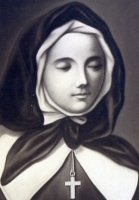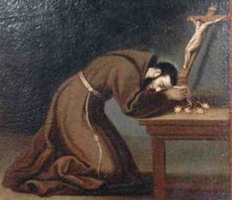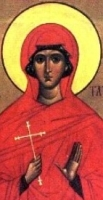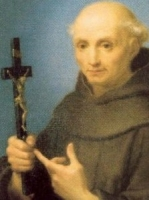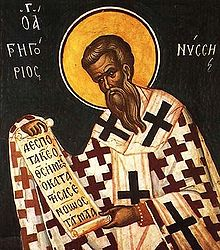Saint Aelred of Rievaulx
Also known as
• Aelred of Revesby
• the English Saint Bernard
• Aethelred, Ailred, Eilred, Ethelred, Aelredus, Alfred, Alred, Ethelredus
Additional Memorials
• 3 February (Cistercians)
• 3 March (dioceses of Hexham, Liverpool and Middlesbrough in England)
Profile
Son of Eilaf, a priest during a period when English priests were allowed to marry, and keeper of the shrine of Hexham. Master of the household of the court of King David of Scotland. Known for his gentle spirituality and his personal austerity amid the court life. David wanted to make his friend a bishop, but instead Aelred left Scotland in 1134 to become a Cistercian monk at Rievaulx, Yorkshire, England. Master of novices. First abbot of a Cistercian monastery in Revensby, Lincolnshire, England in 1142. Abbot of Rievaulx in 1147, which made the superior of all Cistercians in England, and kept him much on the road, travelling from house to house, preaching throughout England and Scotland. Peacemaker among the Picts in Galway, ending disputes and revitalizing the faith in the area. He composed sermons and prayers, wrote works on the spiritual and aescetic life, wrote on the lives of King David of Scotland, Saint Ninian and Saint Edward the Confessor, and was considered a living saint by those who knew him.
Born
1110 at Hexham, England
Died
• 12 January 1167 at Rievaulx Abbey, Yorkshire, England of kidney disease
• buried in the Rievaulx Chapter House
• relics translated to the abbey church and enshrined behind the high altar in 1191
Canonized
• never formally canonized
• cultus and devotion developed immediately after his death
• cultus approved by the Cistercian general chapter in Cîteaux in 1476
Patronage
• against kidney disease
• against kidney stones
Representation
• abbot holding a book
• abbot holding a scroll
Saint Marguerite Bourgeous
புனிதர் மார்கரெட் பார்கெயாய்ஸ்
மாண்ட்ரியல் நோட்ரெடேம் சபையின் நிறுவனர்:
பிறப்பு: ஏப்ரல் 17, 1620
ரோயெஸ், ச்சம்பக்ன், ஃபிரான்ஸ் அரசு
இறப்பு: ஜனவரி 12, 1700 (வயது 79)
வில்-மேரி கோட்டை, நியு ஃபிரான்ஸ், ஃபிரெஞ்ச் காலனியல் பேரரசு
ஏற்கும் சமயம்:
ரோமன் கத்தோலிக்க திருச்சபை
ஆங்கிலிக்கன் திருச்சபை – கனடா
முக்திபேறு பட்டம்: நவம்பர் 12, 1950
திருத்தந்தை பன்னிரெண்டாம் பயஸ்
புனிதர் பட்டம்: அக்டோபர் 31, 1982
திருத்தந்தை இரண்டாம் ஜான் பவுல்
முக்கிய திருத்தலம்:
நோட்ரெடேம்-டி-போன்-செகௌர்ஸ் சிற்றாலயம், மாண்ட்ரியல், கியுபெக், கனடா
நினைவுத் திருநாள்: ஜனவரி 12
பாதுகாவல்:
வறுமைக்கு எதிராக, பெற்றோரை இழந்தவர்கள், ஆன்மீக சபைகளால் நிராகரிக்கப்பட்டவர்கள்
புனிதர் மார்கரெட் பார்கெயாய்ஸ், கனடா நாட்டின் “கியுபெக்” (Québec) பிராந்தியத்தின் இன்றைய பாகமான “நியு ஃபிரான்ஸ் காலனியில்” (Colony of New France) “மாண்ட்ரியலிலுள்ள நோட்ரெடேம் சபையை” (Congregation of Notre Dame of Montreal) நிறுவியவராவார். கி.பி. 1653ம் ஆண்டில், “வில்-மேரி கோட்டையில்” (Fort Ville-Marie) (தற்போதய மாண்ட்ரியல்) வாழ்ந்தவ இவர், இளம் பெண்களுக்கும், ஏழைகளுக்கும், பூர்வீக குடிகளுக்கும் பதினெட்டாம் நூற்றாண்டின் ஆரம்பத்தில் தமது மரணம் வரை கல்வி கற்பித்தவர் ஆவார்.
புனிதர் மார்கரெட் பார்கெயாய்ஸ், ஃபிரான்ஸ் அரசின் பழங்கால “ச்சம்பக்ன்” (Champagne) பிராந்தியத்திலுள்ள “ட்ரோயெஸ்” (Troyes) எனுமிடத்தில் கி.பி. 1620ம் ஆண்டு, ஏப்ரல் மாதம், 17ம் தேதி பிறந்தவர் ஆவார். இவரது தந்தையார் பெயர், “ஆபிரகாம் பார்கெயாய்ஸ்“ (Abraham Bourgeoys) ஆகும். தாயாரின் பெயர், “கில்லேமெட் கார்னியர்” (Guillemette Garnier) ஆகும். இவர், தமது பெற்றோருக்குப் பிறந்த பன்னிரண்டு குழந்தைகளில் ஆறாவது குழந்தை ஆவார். சமூகப் பின்னணி கொண்ட மத்தியதர குடும்பத்தைச் சேர்ந்த இவரது தந்தை, ஒரு மெழுகுதிரி உற்பத்தியாளர் ஆவார். இவர் சிறுமியை இருக்கையில் இவரது தந்தையார் மரித்துப் போனார். இவருக்கு பத்தொன்பது வயதாகையில் இவரது தாயாரும் மரித்துப் போனார்.
மார்கரெட், ஏழைப் பெண்களின் கல்விக்கு ஆதரவளித்த பிரபலமானவர்களில் ஒருவரல்ல. அவர், சொந்த மனநிலையுடனும் தைரியத்துடனுமிருந்தார். அவர் ஒரு கடின வாழ்க்கை முறையில் வளர்ந்தவர் ஆவார். தமக்கு பதினைந்து வயதாகையில், தமது குடும்பத்தினரின் விருப்பத்தைக் காட்டிலும், தமது விருப்பத்தின்படி நடக்க முடிவு செய்தார். பின்னர், மார்கரெட் தனது ஆரம்ப காலங்களில் ஒரு விரிவுரையாளராக நன்கு அறியப்பட்டார். அவர் கடவுள் நம்பிக்கை கொண்டவராகவும், அவர் தேர்ந்து பேசியவற்றில் உண்மையில் ஆன்மிகமும் இருந்தது.
கி.பி. 1653ம் ஆண்டு, ஃபெப்ரவரி மாதம், மார்கரெட் தன் சொந்த நாடான பிரான்சில் இருந்து “செயின்ட் நிக்கோலஸ்” (Saint-Nicholas) என்ற கப்பலில் கடல் பயணம் செய்தார். அவருடன் சுமார் நூறு பேர் இருந்தனர். அவர்களில் பெரும்பாலோனோர், வேலைகளுக்காக ஒப்பந்தங்களில் கையெழுத்திட்டு சேர்ந்த ஆண்கள் இருந்தனர்.
செப்டம்பர் மாதம் 22ம் தேதி, “கியூபெக்” (Port of Quebec City) நகரின் துறைமுகம் சென்றடைந்த அவருக்கு, “ஊர்சுலின்” (Ursuline nuns) அருட்சகோதரியர் வரவேற்பளித்தனர். மற்றும் “வில்-மேரி” (Ville-Marie) செல்வதற்கான பயண ஏற்பாடுகளும் செய்திருந்தனர். அவர் அந்த வாய்ப்புகளை மறுத்து, ஏழை குடியேறியோருடன் கியூபெக்கில் தங்கியிருந்தார். மாண்ட்ரியலில் உள்ள அவரது சபையின் எதிர்காலம் மற்றும் எதிர்கால தன்மையின் இந்த குறிப்புகள் - கடவுளுடைய சித்தத்தை பரப்ப ஒரு மதச்சார்பற்ற மற்றும் நடைமுறை அணுகுமுறையாக இருந்தது. நவம்பர் மாதம் 16ம் நாள் அவர் “வில்-மேரி” (Ville-Marie) சென்றடைந்தார்.
புதிய பிரான்சில் மார்கரெட் வாழ்க்கையின் இந்த காலகட்டம், விரிவாக்க நோக்கம் மற்றும் செல்வாக்கைப் பொறுத்தவரையில் அவரது பிற்பகுதியுடன் ஒப்பிடுகையில், அது மிகவும் நெருக்கமானதாகவே காணப்படுகிறது. காலனியிலுள்ள ஒவ்வொருவரும் மார்கரெட்டை அறிந்திருந்தனர். இருப்பினும், அவர் அங்கு முதல் ஆண்டுகளில் கடினமான போராட்டங்களை எதிர்கொண்டார். குழந்தைகளின் இறப்பு விகிதம் அங்கே அதிகரித்திருந்த காரணத்தால், கல்வி கற்க அங்கே குழந்தைகள் வரவில்லை. இதன் காரணமாக, கல்வி கற்பிப்பதற்கான தனது திட்டத்தில் அவர் விரக்தியடைந்தார். இதைத் தவிர, சமூகத்துக்கு எந்த வகையிலும் உதவுவதற்கு அவர் தன்னை தானே அமைத்துக்கொண்டார். பெரும்பாலும் குடியேற்றக்காரர்களுடன் சேர்ந்து பணியாற்றினார்.
இந்த ஆரம்ப வருடங்களில், சில குறிப்பிடத்தக்க முயற்சிகள் செய்து நிர்வகிக்க மார்கரெட்டால் முடிந்தது. கி.பி. 1657ம் ஆண்டு, “வில்-மேரியில்” (Ville-Marie) முதல் நிரந்தர தேவாலயமான, “நல்ல ஆலோசனை அன்னை” (The Chapel of Our Lady of Good Counsel) சிற்றாலயம் கட்டும் பணியை ஏற்றுக்கொண்டார். கி.பி. 1658ம் ஆண்டு, ஏப்ரல் மாதம், அவருடைய மாணவர்களுக்காக ஒரு பள்ளி இல்லம் கட்டுவதற்கான காலி மனை, “நியு ஃபிரான்சில்” (New France) “மாண்ட்ரியல்” (Montreal) நிர்மாணித்த ஃபிரான்ஸ் நாட்டின் இராணுவ அதிகாரியான “மைஸ்சொன்னெவ்” (Maisonneuve) என்பவரால் வழங்கப்பட்டது. மார்கரெட் வந்து ஐந்தே ஆண்டு காலத்தின் பிறகு, மாண்ட்ரியலில் பொதுப் பள்ளிகள் உருவாக இதுவே ஆரம்பமாக அமைந்தது. இன்று ஒரு நினைவு சின்னம் “பழைய மாண்ட்ரியலில்” (Old Montreal) நிலையான பள்ளியின் தளத்தை குறிக்கிறது. இந்நினைவுத் சின்னமானது, “செயிண்ட்-டிஸியர்” (Saint-Dizier) மற்றும் “செயின்ட்-பால்” (Saint-Paul) தெருக்களின் தென்மேற்கு மூலையில் உள்ள ஒரு சுவரில் காணப்படுகின்றது. பள்ளிகளின் ஸ்திரத்தன்மையை பெற்ற பின்னர், மேலும் அதிக பெண்களை கற்பிக்கும் பணிக்கு கொண்டு வரும் நோக்கத்துடன் தாயகமான ஃபிரான்ஸ் புறப்பட்டுச் சென்றார்.
சரியான நேரத்தில், சரியான இடத்தில் “அரசனின் மகள்களை” (King's Daughters) கவனித்துக்கொள்ளும் பணியில் மார்கரெட் வெற்றி பெற்றிருந்தார். காலனியில் குடும்பங்களை ஸ்தாபிக்கும் காரணத்துக்காக, ஐரோப்பிய நாடுகளிலிருந்து வந்திருந்த அனாதைப் பெண்களை அரசாங்கமே அனுப்பி வைத்தது. மனைவி வேண்டி வந்த காலனியின் ஆண்களை பரீட்சித்து அவர்களுக்கு பொருத்தமான பெண்களை மனம் செய்து வைப்பதும் மார்கரெட் மற்றும் அவரது நான்கு இணை தோழமைகளின் பொறுப்பாகவும் இருந்தது.
நியு ஃபிரான்ஸ் காலனியை ஸ்தாபிப்பதிலும் அதனை வளர்ப்பதிலும் மார்கரெட் காட்டிய ஈடுபாடு அளப்பற்றது. கல்வியிலும் எண்ணற்ற பள்ளிகள் மற்றும் கல்லூரிகளை நிறுவி நிர்வகித்தார்.
சிறந்த ஆசிரியரான மார்கரெட் பார்கெயாய்ஸ், கி.பி. 1700ம் ஆண்டு, ஜனவரி மாதம் 12ம் நாள், அமைதியாக மரித்தார்.
“அரசனின் மகள்கள்” (King's Daughters):
“அரசனின் மகள்கள்” (King's Daughters) என்பது, சுமார் 800 இளம் பிரெஞ்சு பெண்களைக் குறிக்கும் ஒரு சொல் ஆகும்.
கனடாவின் மக்கள்தொகையை அதிகரிப்பதற்காக “அரசன் பதினான்காம் லூயிசால்” (Louis XIV) சில திட்டங்கள் வடிவமைக்கப்பட்டன.
இதன் முக்கிய இரண்டு பகுதிகளாவன:
1. புலம்பெயர்ந்து வந்த ஆண்களை நிரந்தரமாக குடியேற ஊக்குவித்தல்.
2. திருமணத்தை ஊக்குவித்தல், குடும்ப உருவாக்கம் மற்றும் குழந்தைகளின் பிறப்பு.
இதற்காக, கி.பி. 1663 மற்றும் 1673ம் ஆண்டுகளுக்கிடையேயான காலத்தில், சுமார் எண்ணூறு இளம் ஃபிரெஞ்ச் பெண்கள் “நியு ஃபிரான்ஸ்” (New France) காலனிக்கு புலம் பெயர்ந்து அழைத்து வரப்பட்டனர். இவர்கள் “அரசனின் மகள்கள்” ((King's Daughters)) என்றும் “அரசனின் பாதுகாவலில் உள்ளவர்கள்” (King's Wards) என்றும் குறிப்பிடப்பட்டனர். இவர்களது பயணத்துக்கான செலவுகள் முழுதும் அரசனால் ஏற்றுக்கொள்ளப்பட்டது.
Also known as
• Margaret Bourgeoys
• Marguerite Bourgeoys
• Marguerite Bourjeoys
Profile
The sixth of twelve children of devout parents. When Marguerite was 19 her mother died, and the young lady cared for her younger brothers and sisters; her father died when she was twenty-seven. The family raised, Marguerite prayed to know what to do with her life. The governor of Montreal, Canada, was in France looking for teachers for the New World. He invited Marguerite to come to Montreal to teach school and religion classes. She agreed and spent the rest of her life in North America.
Marguerite gave away her share of her parents' inheritance to other members of the family, and in 1653 sailed for Canada. She began construction of a chapel to honor Our Lady of Good Help, and opened her first school in 1658. She returned to France in 1659 to recruit more teachers, and returned with four; in 1670, she went to France again, and brought back six more. These brave women became the first sisters of the Congregation of Notre Dame.
Marguerite and her sisters helped people in the colony survive when food was scarce, opened a vocational school, taught young people how to run a home and farm. Marguerite's congregation grew to 18 sisters, seven of them Canadian. They opened missions, and two sisters taught at the Native American mission. Marguerite received the first two Native American women into the congregation.
In 1693, Mother Marguerite handed over her congregation to her successor, Marie Barbier, the first Canadian to join the order. Marguerite's religious rule was approved by the Church in 1698, and Marguerite spent her last few years praying and writing an autobiography. On the last day of 1699, a young sister lay dying. Mother Marguerite asked the Lord to take her life in exchange. By the morning of 1 January 1700, the sister was completely well, Mother Marguerite had a raging fever, suffered 12 days, and died on 12 January 1700.
Born
17 April 1620 at Troyes, Aube, France
Died
12 January 1700 at Montreal, Quebec, Canada of fever
Canonized
31 October 1982 by Pope John Paul II
Patronage
• against death of parents
• against impoverishment
• against poverty
• people rejected by religious orders
• poor people
Saint Benedict Biscop
புனிதர் பெனடிக்ட் பிஸ்காப்
ஆங்கிலோ-சாக்சன் மடாதிபதி மற்றும் நிறுவனர்:
பிறப்பு: கி.பி. 628
நார்தும்ப்ரியா
இறப்பு: ஜனவரி 12, 690
செயிண்ட் பீட்டர்ஸ், வேர்ல்மவுத் (சுந்தர்லேண்ட்)
ஏற்கும் சமயம்:
ரோமன் கத்தோலிக்க திருச்சபை
இங்கிலாந்து திருச்சபை
மரபுவழி திருச்சபை
நினைவுத் திருநாள்: ஜனவரி 12
பாதுகாவல்:
ஆங்கிலேய பெனடிக்டைன்ஸ், இசைக்கலைஞர்கள், ஓவியர்கள், சுண்டர்லேண்ட் நகரம், நார்த்தும்பர்லேண்டிலுள்ள புனித பெனடிக்ட் பிஸ்கொ கத்தோலிக்க அகாடமி
"பெனடிக்ட் பிஸ்காப்" (Benedict Biscop) என்றும், "பிஸ்காப் படூசிங்" (Biscop Baducing) என்றும் , அறியப்படும் இப்புனிதர், ஒரு "ஆங்கிலோ ஸாக்ஸன்" மடாதிபதியும் (Anglo-Saxon abbot), இங்கிலாந்து (England) நாட்டின் "நார்தும்ப்ரியா ராச்சியத்திலுள்ள" (Kingdom of Northumbria) "மோன்க்வியர்மவுத்-ஜரோ மடாலய" (Monkwearmouth–Jarrow Abbey) நிறுவனருமாவார்.
நார்தும்பரியன் பிரபுக்கள் குடும்பமொன்றில் பிறந்த பெனடிக்ட், தமது வாழ்நாளில் ஐந்து தடவை ரோம் நகருக்கு திருயாத்திரை சென்றிருக்கிறார். தமது முதல் திருயாத்திரையை தமது 25வது வயதில், தமது நண்பரான "புனிதர் மூத்த வில்ஃபிரிட்" (Saint Wilfrid the Elder) என்பவருடன் சென்றார். எனினும், வழியில், ஃபிரான்ஸ் நாட்டின் மூன்றாவது பெரிய நகரான "லியோனில்" (Lyon) வில்ஃபிரிட் தங்கிவிடவே, பெனடிக்ட் தமது பயணத்தை தனியே தொடர்ந்தார். பெனடிக்ட் இங்கிலாந்துக்கு திரும்பி வருகையில், ஆங்கிலேய திருச்சபையின் நன்மைக்காக ஆர்வமும், உற்சாகமும் நிறைந்திருந்தார்.
சரியாக பன்னிரெண்டு வருடங்கள் கழித்து இரண்டாம் தடவையாக ரோம் பயணித்த பெனடிக்ட், இம்முறை "அரசன் ஓஸ்வியு" (King Oswiu) என்பவரின் மகனான "அல்ச்ஃபிரித்" (Alchfrith of Deira) என்பவரை உடன் அழைத்துச் சென்றார். இந்த தமது பயணத்தில், அவர் "ஹெக்ஸம்" ஆயரும் (Bishop of Hexham), நார்தும்பரியன் புனிதருமான "அக்கா" (Acca of Hexham) என்பவரையும், ஆங்கிலேய ஆயரும் (English Bishop), புனிதருமான "வில்ஃபிரிட்" (Wilfrid) என்பவரையும் சந்தித்தார். இம்முறை, ரோம் நகரிலிருந்து இங்கிலாந்து திரும்பும் பயணத்தின்போது, "புரோவென்ஸ் மத்தியதரைக் கடலோரப் பகுதியின்" (Mediterranean coast of Provence) "லெரின்ஸ்" (Lérins) எனும் துறவியர் தீவில் (Monastic Island) தங்கினார். அங்கே அவர் தங்கியிருந்த கி.பி. 665ம் ஆண்டு முதல் கி.பி. 667ம் ஆண்டு வரையான இரண்டு வருட காலம் போதிப்பதற்கான வழிமுறைகளை கற்றுக்கொண்ட அவர், துறவரத்துக்கான சத்திய பிரமாணங்களை ஏற்றுக்கொண்ட அவர், பெனடிக்ட் என்ற பெயரையும் ஏற்றுக்கொண்டார்.
இரண்டு வருடங்களுக்குப் பிறகு பெனடிக்ட், "லெரின்ஸ்" (Lérins) தீவிலிருந்தே ரோம் நகருக்கு தனது மூன்றாவது பயணத்தை மேற்கொண்டார். இம்முறை அவர், கி.பி. 669ம் ஆண்டு, "காண்டர்பரி" (Canterbury) திரும்பிச் செல்லும் "பேராயர் தியோடோர்" (Archbishop Theodore of Tarsus) என்பவருடன் துணையாகச் செல்லுமாறு திருத்தந்தையால் பணிக்கப்பட்டார். "காண்டர்பரி" திரும்பியது, பேராயர் அவரை அங்குள்ள "தூய அகுஸ்தினார் மடாலயத்தின்" (St Augustine's Abbey) மடாதிபதியாக நியமித்தார். இப்பதவியில் அவர் இரண்டு வருடங்கள் நீடித்தார்.
புத்தகங்களைப் பெரிதும் விரும்பும் பெனடிக்ட், அவரது பயணத்தின்போது ஒரு நூலகத்துக்கான புத்தகங்களை ஒன்றுதிரட்டினார். ரோமுக்குச் சென்ற இரண்டாவது பயணம் ஒரு புத்தகம் வாங்கிய பயணமாக அமைந்தது. மொத்தத்தில், இந்த சேகரிப்பு கிட்டத்தட்ட 250 தலைப்பிலான புத்தகங்களை - பெரும்பாலும் சேவை புத்தகங்களைக் கொண்டிருந்தது. இந்நூலகம், இறையியல் மற்றும் பண்டைய இலக்கியம் மற்றும் மதச்சார்பற்ற படைப்புகளை உள்ளடக்கியிருந்தது.
கி.பி. 674ம் ஆண்டு, நார்தும்ப்ரியா அரசனான "எக்ஃபிரித்" (Ecgfrith of Northumbria), துறவு மடாலயம் கட்டுவதற்கான நிலத்தை பெனடிக்டுக்கு வழங்கினார். பெனடிக்ட், தமது நூலகத்துக்கான புத்தகங்களையும், புனிதர்களின் நினைவுச்சின்னங்களையும் கொண்டு வருவதற்காகவும், புதிதாய் கட்டப்படவுள்ள மடாலயத்துக்கான கல் தச்சர், கண்ணாடிப் பணியாளர் ஆகியோரை அழைத்து வருவதாகவும், தமது மடாலயத்துக்கான சில சிறப்பு சலுகைகளை "திருத்தந்தை அகத்தோ" (Pope Agatho) அவர்களிடமிருந்து வாங்குவதற்காகவும், ரோம் நகருக்கான தமது கடைசி மற்றும் ஐந்தாவது திருப்பயணத்தை கி.பி. 679ம் ஆண்டு தொடங்கினார். தாம் தமது ஐந்து வெளிநாட்டுப் பயணங்களில் சேகரித்த அனைத்தையும் தமது நூலகத்தில் இருப்பு வைத்தார்.
பெனடிக்ட், தமது கடைசி மூன்று வருடங்களை நோய்ப்படுக்கையில் கழித்தார். அவர் மிகுந்த பொறுமையுடன் விசுவாசத்துடன் துன்பத்தை அனுபவித்தார். அவர் கி.பி. 690ம் ஆண்டு, ஜனவரி மாதம், 12ம் நாளன்று, இறைவனில் மரித்தார்.
Also known as
• Benet Biscop
• Biscop Baducing
Profile
Anglo-Saxon nobility. Grew up around the court of King Oswy of Northumbria, and held court offices. Following a pilgrimage to Rome he renouced his wealth and position, and dedicated himself to prayer and scripture study. Monk at the monastery of Saint-Honorat near Cannes, France in 666, taking the name Benedict.
In 668 Pope Saint Vitalian sent him and the monk Adrian to advise Theodore, Archbishop of Canterbury until 671. Traditionally introduced the construction of stone churches and glass church windows to England, and brought in many foreign craftsman to do the work and teach the English. Tried to introduce more Roman rituals to English worship. Founded the monasteries of Wearmouth and Jarrow. Built a large library and scriptorium at Wearmouth.
In late life Benedict suffered a painful paralysis, and was confined to his bed for his last three years. He continued to work from his bed, buying books, establishing the Benedictine Rule.
Born
c.628 in Northumbria, England as Benet Biscop
Died
• 12 January 690 of natural causes at Wearmouth, England
• relics at Thorney abbey and Glastonbury, England
Patronage
• English Benedictines
• musicians
• painters
• Sunderland, England
Representation
• Benedictine abbot dressed as a bishop standing by the Tyne with two monasteries nearby
• with the Venerable Bede
Blessed Pierre-François Jamet
Also known as
• Peter Francis Jamet
• Second Founder of the Institute of the Good Savior
Profile
One of eight children born to a wealthy farm family. Studied at the College of Vire, then the University of Caen. Ordained on 22 September 1787 in the diocese of Bayeaux, France. Chaplain and confessor to the Daughters of the Good Savior in Caen, France in 1790. He tried to continue his studies, but the French Revolution ended the teaching of theology. He was imprisoned for refusing to swear the oath required by the anti-Church Revolutionary authorities, who then dispersed the Daughters community. Upon his released, Father Pierre continued to minister to the sisters and other covert Catholics, conducting Mass in secret. After the Revolution execesses, he devoted himself to restoring and revitalizing the Daughters. Helped found a school devoted to and new teaching methods for the deaf. Rector of the University of Caen from 1822 to 1830. Awarded the Legion of Honour in 1827 in recognition of his good works.
Born
12 September 1762 in Fresnes, Aisne, France
Died
• 12 January 1845 in Caen, Calvados, France of natural causes
• buried in the motherhouse of the Daughters of the Good Savior in Caen
Beatified
10 May 1987 by Pope John Paul II
Blessed Nicholas Bunkerd Kitbamrung
Also known as
• Benedikto Chunkim
• Benedikto Xunkim
• Nicholas Bunker Kitbamrung
• Nikholas Buykoet Krisbamrung
• Nikola Bunkerd Kitbamrung
Profile
One of six children. His parents were converts, and he was raised as a Christian. Entered the Hang Xan Minor Seminary at age 13, and the Penang Major Seminary, Malaysia in 1920. Ordained in the archdiocese of Bangkok, Thailand in 1926. Pastor at Bang Nok Khneuk and Phitsanulok. Missionary to northern Vietnam from 1930 to 1937, working to bring back Catholics who had fallen from their practice due to poverty.
When war broke out between France and Indochina, Nicholas was accused of spying for the French. In 1941 he was arrested and sentenced to 10 years in prison. There he contracted tuberculosis which, with the hardships of prison, eventually killed him, but not before he spent two years bringing the faith to his fellow prisoners, baptizing at least 68. Thailand's first martyr priest.
Born
28 February 1895 at Sam Phran, Nakhon Pathom, Thailand
Died
12 January 1944 of tuberculosis at Bangkok, Thailand
Beatified
5 March 2000 by Pope John Paul II at Saint Peter's Square, Rome, Italy
Saint Antony Mary Pucci
Also known as
• Anthony Mary Pucci
• Antonio Maria Pucci
• Eustacchio Pucci
• Il Curatino
Profile
Second of seven children from a peasant family. His father was sacristan of the local church, but he opposed his son's interest in religious life. At age 18 Eustacchio joined the Servites, taking the religious name of Antony Mary. He studied the classics and theology. Ordained in 1843. Assigned at age 28 as parish priest in the seaside town of Viareggio, Italy where he spent the rest of his life, working 45 years in service to his flock. Called il curatino, "the little parish priest" by his parishioners. Had special devotion to the sick, the aged, and the poor, serving with distinction during two epidemics in the town. Founded a seaside nursing home for children, and served as Servite provincial from 1883 to 1890.
Born
16 April 1818 in Poggiole di Vernio, Italy as Eustacchio Pucci
Died
• 12 January 1892 at Viareggio, Italy
• interred in the church of Sant'Andrea in Viareggio
Canonized
9 December 1962 by Pope John XXIII
Patronage
Vernio, Italy
Saint Arcadius of Mauretania
Profile
Wealthy and prominent citizen, and a closet Christian. During a persecution in Mauritania, he withdrew to live as a hidden hermit, prayerful and out of harm's way. The authorities wanted to use him as an example, and arrested a relative, threatening him with harm unless Arcadius turned himself in. Arcadius came in from the forests and went straight to court to trade himself for his kinsman. The judge said he would release the prisoners only if Arcadius would publicly sacrfice to a pagan god. Arcadius declined; martyr. As he was mutilated to death, he continued to preach Jesus to the watching pagans.
Died
slowly hacked to death one joint, appendage and limb at a time c.302 at Caesarea, Mauritania (near modern Algiers)
Representation
• early Christian martyr with a club in his hand
• early Christian with a lighted taper
• man on a rack
• man with his limbs chopped off
Saint Martin of Leon
Also known as
Martin of the Holy Cross
Profile
Educated in the monastery of Saint Marcellus at Leon, Spain. Pilgrim to Rome, Italy, and to Constantinople. Augustinian canon regular at Saint Marcellus abbey. Priest. When his monastery was secularized, he entered the collegiate church of Saint Isidore at Leon. Wrote commentaries on the Epistles and Revelations, and discourses on varied subjects. Known during his lifetime for his holiness and ascetical writings.
Born
in León, Old Castile, Spain
Died
• 12 January 1203 at León, Spain of natural causes
• relics enshrined in the San Martin chapel in the collegiate church of León in 1513
Canonized
• the religious of Saint Isidore's dedicated a chapel to Martin very early, and celebrated his feast each year
• in 1964 the Sacred Congregation of Rites approved his feast for the diocese of León, Spain
Saint Bernard of Corleone
கார்லியோன் நகர் புனிதர் பெர்னார்ட்
மறைப்பணியாளர் :
பிறப்பு : ஃபெப்ரவரி 6, 1605
கார்லியோன், சிசிலி, சிசிலி அரசு
இறப்பு : ஜனவரி 12, 1667 (வயது 61)
பலெர்மோ, சிசிலி, சிசிலி அரசு
ஏற்கும் சமயம் :
ரோமன் கத்தோலிக்க திருச்சபை
முக்திபேறு பட்டம் : மே 15, 1768
திருத்தந்தை பதின்மூன்றாம் கிளமென்ட்
புனிதர் பட்டம் : ஜூன் 10, 2001
திருத்தந்தை இரண்டாம் ஜான் பவுல்
நினைவுத் திருநாள் : ஜனவரி 12
பாதுகாவல் : கொர்லியோன் (Corleone)
"ஃபிலிப்போ லட்டினோ" (Filippo Latino) என்னும் இயற்பெயர் கொண்ட புனிதர் பெர்னார்ட், ஒரு கத்தோலிக்க புனிதர் ஆவார். இவர், கி.பி. 1605ம் ஆண்டு, ஃபெப்ரவரி மாதம், 6ம் நாளன்று, “சிசிலி” (Kingdom of Sicily) அரசில் உள்ள “கார்லியோன்” (Corleone) என்ற இடத்தில் பிறந்தவர் ஆவார். இவரது தந்தையார் ஒரு செருப்பு தைக்கும் தொழிலாளி ஆவார். இவரும் தந்தையின் தொழிலான செருப்பு தைக்கும் பணியையே கற்று செய்து வந்தார். இவரது தந்தை இறந்ததும் இவர் ராணுவத்தில் சேர்ந்தார். கத்தி சண்டை கற்று அதில் சிறந்த திறன் பெற்றார். சிறு ஆத்திரமூட்டும் சம்பவத்திற்கும் கத்தியை உரையிலிருந்து உருவும் மனப்பாங்கு கொண்டிருந்தார்.
குறிப்பிடத்தக்க வகையில் மதப்பற்று கொண்டிராதவராயிருப்பினும், முதியோர்களை பாதுகாப்பதிலும், பாதுகாப்பற்ற மற்றும் உதவியற்ற நிலையில் உள்ளவர்களையும் வன்முறைகளில் இருந்து பாதுகாப்பு கொடுப்பதில் ஆர்வமுள்ளவராக இருந்தார். உள்ளூரில் உள்ள ஒரு சிலுவையடிக்கு அடிக்கடி சென்று ஒரு விளக்கு எப்போதும் அங்கு எரிந்துகொண்டிருக்குமாறு பார்த்துக்கொள்வார். இவர், புனிதர் அசிசியின் ஃபிரான்ஸிசிடம் பக்தியுள்ளவராய் இருந்தார்.
கி.பி. 1624ம் ஆண்டில் ஒருமுறை, ஃபிலிப்போ தமது பத்தொன்பது வயதில் ஒருவனுடன் சண்டையில் ஈடுபட நேரிட்டது. தமது எதிரிக்கு எதிராக ஆயுதம் எடுத்து சண்டையிட வேண்டியிருந்தது. இதனை பலபேர் பார்த்துக்கொண்டிருந்தனர். கூச்சலும் கிளர்ச்சிகளும் எழுந்தன. மக்கள் இவருக்கு "சிசிலியின் சிறந்த கத்தி" (The Finest Blade in Sicily) என்ற பட்டப்பெயர் இட்டனர். அம்மனிதனின் சண்டையிலிருந்து தப்புவதற்காக, இவர் "கப்புச்சின் ஃபிரான்சிஸ்கன்" (Capuchin Franciscans) சபையில் தஞ்சமடைய முயன்றார்.
துறவிகளுடன் அங்கே இருந்த காலத்தில் தமது கடந்த காலத்தை நினைத்துப் பார்த்தார். ஆத்திரமூட்டும் தமது கலவர குணத்திற்காக சுயபச்சாதாபப்பட்டு வருந்தினார். கப்புச்சின் சபையில் திருத்தொண்டராக சேர விண்ணப்பித்தார். கி.பி. 1632ம் ஆண்டு, டிசம்பர் மாதம், 13ம் நாளன்று, அவர் துறவற புகுநிலையினராக (Novitiate) இணைந்தார். ஃபிலிப்போவின் ஆன்மீக முயற்சிகள் மிகவும் கடினமானதாக இருந்தன. தினமும் ஏழு தடவையாவது அவர் தம்மைத்தாமே சாட்டை போன்றதொரு வாரினால் இரத்தம் சொட்டச் சொட்ட அடித்துக்கொள்வார். தினமும் மூன்று மணிநேரம் மட்டுமே ஒரு குறுகலான பலகையில் படுத்து உறங்குவார். தலைக்கு சிறு கட்டை ஒன்றினை வைத்துக்கொள்வார். கடும் நோன்பிருந்த அவர், ரொட்டியும் தண்ணீருமே அருந்தினார். இத்தகைய கடின உடல் உழைப்பும், உண்ணா நோன்பும், ஓய்வின்மையும், உணவுப்பழக்கங்களும், இவரை பின்னாட்களில் நோயில் அவதியுற வைத்தன. இவர் (Rheumatism) எனப்படும் கீழ்வாத நோயால் பாதிக்கப்பட்டிருந்தார். வேதனையால் நாள்தோறும் அவதிப்பட்டார்.
பெர்னார்ட், அன்னை அர்ச்சிஷ்ட கன்னி மரியாளிடம் தீவிர பக்தி கொண்டிருந்தார். அவர் இறை அன்னையின் மீதிருந்த தமது பக்தியை பிறரிடமும் பரப்பினார். இவரது வாழ்க்கை வரலாற்று ஆசிரியர்கள், இறை அன்னை கன்னி மரியாள் குழந்தை இயேசுவுடன் இவருக்கு காட்சியளித்ததாகவும், குழந்தை இயேசுவை அவரது கைகளில் தந்ததாகவும் கூறுகின்றனர். கடவுளின் தாயான அதிதூய கன்னி மரியாள் இவரது மரண நாளை நான்கு மாதங்கள் முன்னதாகவே அறிவித்ததாகவும் கூறுகின்றனர். அன்னை முன்னறிவித்தபடியே பெர்னார்ட், கி.பி. 1667ம் ஆண்டு, ஜனவரி மாதம், 12ம் நாளன்று, "பலெர்மோ" (Palermo) என்ற இடத்தில் நித்திய வாழ்வில் தோழமை கொள்ள புனிதருள் மரித்தார். இவரது கல்லறையில் எண்ணற்ற அற்புதங்கள் இன்றளவும் நடக்கின்றன.
Also known as
• Bernardo de Corleone
• Filippo Latino
• Philipi Latini
Profile
Shoemaker by trade, and considered the greatest swordsman and duelist in Sicily in his day. After mortally wounding a man named Canino in a duel, he sought sanctuary from the law in the church of the Capuchin Friars Minor in Palermo. While hiding there, he had a true conversion, and became a Capuchin lay-brother in 1632, changing his name to Brother Bernardo.
Noted for his extreme austerity and self-imposed penances in an attempt to atone for his earlier life. Had the gift of healing animals by prayer.
Born
6 February 1605 at Corleone, Palermo, Sicily as Filippo Latino
Died
12 January 1667 at Palermo, Sicily
Canonized
10 June 2001 by Pope John Paul II
Blessed Lucia of Valcaldara
Also known as
Lucia of Norcia
Profile
Born to a wealthy family, Lucia was drawn to religious life as a child, and at age 15 she made private vows. With seven like-minded friends, she founded a religious community that set such an example that on 28 January 1386 the City Council voted to help them, and the group moved to the convent of San Girolamo. She founded a monastery and the church of Santa Maria in the Valcadara community of Norcia, Italy in 1390. In 1407 the group received approval, taking the rule of the Poor Clares.
Born
1370 in Norcia, Perugia, Italy
Died
• 12 January 1430 of natural causes
• relics enshrined in the monastery of the Poor Clares of Santa Maria della Pace in 1637
Saint Martinian of Belozersk
Also known as
• Martinian of Byelozersk
• Martinian of the White Lake
• Martinian of the Black Sea
• Martinien, Martinianus
Additional Memorial
7 October (discovery of his relics)
Profile
Born to a poor family, his parents entrusted the boy Martinian to the monastery at White Lake. Spiritual student of Saint Cyril. Monk. Priest. Abbot of the Trinity Laura of Saint Sergius. Advisor to the Grand Prince of Moscow. In his old age he retired to the monastery at White Lake.
Born
1398
Died
1483 at the monastery of White Lake of natural causes
Blessed John Gaspard Cratz
Also known as
• Johann Kaspar Kratz
• Joanes Kaspar Kratz
Profile
Spent several years as a young adult travelling around Europe. Employee of the Dutch East India Company in 1727. Joined the Jesuits at Macao in 1730. Missionary to the kingdom of Tonkin (modern Vietnam). Ordained in 1734. Arrested in March 1736. Tortured and martyred for his work.
Born
15 September 1698 at Golzheim, Düren, Germany
Died
beheaded in 1737 in Tonkin (modern Vietnam)
Blessed Antoine Fournier
Also known as
Antonio
Additional Memorial
2 January as one of the Martyrs of Anjou
Profile
Married lay man craftsman of the diocese of Angers, France. Martyred in the persecutions of the French Revolution.
Born
26 January 1736 in La Poitevinière, Maine-et-Loire, France
Died
shot on 12 January 1794 in Avrillé, Maine-et-Loire, France
Beatified
19 February 1984 by Pope John Paul II at Rome, Italy
Saint Caesaria of Arles
Also known as
Cesarie, Cesira
Profile
Sister of Saint Caesarius of Arles. Founder of a convent in 512; the house soon grew to hundreds of nuns, many of them widows. Caesaria served as its first abbess. She was devoted to the care of the poor, the sick, and children. Saint Gregory of Tours and Saint Venantius Fortunatus wrote of her gifts.
Born
c.465
Died
c.530 of natural causes
Saint Victorian of Asana
Profile
Founded monasteries and hospices in Italy. Travelled and settled briefly in France. Founded and directed a community of monks at Asana (modern Saint Victorian) in the diocese of Barbastro, in the Spanish Pyrenees. Saint Venantius Fortunatus wrote well of him.
Born
Italian
Died
• c.560 in Spain of natural causes
• relics at Montearagón Abbey, Spain
Saint Tatiana of Rome
Also known as
Martina, Tatienne
Profile
Daughter of a Roman consul. Tortured and martyred in the persecutions of Emperor Alexander Severus.
Died
beheaded c.226 in Rome, Italy
Patronage
students, school children
Blessed Bernardo de Plano
Profile
Mercedarian friar involved in the ransoming of Christians enslaved by Muslims. Master-General of the Order on 3 November 1417.
Born
French
Died
12 January 1419 at the monastery of San Martino, Perpignan, France of natural causes
Saint Ferréolus of Grenoble
Also known as
Fergeol, Ferréolo
Profile
Bishop of Grenoble, France. Killed while preaching to a crowd. Martyr.
Died
• beaten to death with a stick on 12 January 659 on Mount Esson
• buried at La Tronche
Beatified
1907 by Pope Saint Pius X (cultus confirmed)
Blessed Emmanuel d'Abreu
Profile
Jesuits priest in 1724. Missionary, assigned to Goa, India in 1733, then in 1734 to Macao to the kingdom of Tonkin (modern Vietnam). Arrested in March 1736. Tortured and martyred for his work.
Born
1708 at Arouca, Portugal
Died
beheaded in 1737 in Tonkin (modern Vietnam)
Blessed Bartholomew Alvarez
Profile
Joined the Jesuits at Coimbra, Portugal. Missionary to the kingdom of Tonkin (modern Vietnam). Arrested in March 1736. Tortured and martyred for his work.
Born
near Braganza, Portugual
Died
beheaded in 1737 in Tonkin (modern Vietnam)
Saint John of Ravenna
Also known as
Jean
Profile
Bishop of Ravenna, Italy from 452 for over 40 years. Saved his flock from the ravages of Attila the Hun. Secured better conditions for his people when Ravenna was captured by King Theodoric of the Ostro-Goths.
Died
494 of natural causes
Saint Tigrius
Also known as
Tygrius
Profile
Priest in Constantinople. Active supporter of Saint John Chrysostom during his exile. To silence him, Tigrius was arrested and exiled on trumped up charges of trying to burn down the Constantinople cathedral and senate.
Died
c.405 in Asia Minor of natural causes
Saint Eutropius
Profile
Lector in Constantinople. Active supporter of Saint John Chrysostom during his exile. To silence him, Eutropius was arrested and exiled on trumped up charges of trying to burn down the Constantinople cathedral and senate.
Died
c.405 in Asia Minor of natural causes
Blessed Vincent de Cunha
Profile
Jesuit. Missionary to the kingdom of Tonkin (modern Vietnam). Arrested in March 1736. Tortured and martyred for his work.
Born
Portuguese
Died
beheaded in 1737 in Tonkin (modern Vietnam)
Saint Satyrus
Also known as
Satyre
Profile
Destroyed a pagan idol by making the sign of the cross at it. Martyred by the pagans who had worshipped the thing.
Born
Arab
Died
267 in Achaea (in modern Greece)
Saint Quinctus the Soldier
Profile
One of a group of 50 soldiers martyred in Africa.
Died
in Africa
Saint Biccianus
Profile
One of a group of 50 soldiers martyred in Africa.
Died
in Africa
Saint Caroticus
Profile
One of a group of 50 soldiers martyred in Africa.
Died
in Africa
Saint Peter of Abessala
Profile
Martyr.
Born
Greece
Died
burned to death in 309
Saint Probus of Verona
Profile
Bishop of Verona, Italy.
Died
late 6th century
Saint Zoticus of Tivoli
Profile
Martyr.
Died
Tivoli, Italy
Martyrs of Africa
Profile
A group of 44 Christian soldiers murdered together for their faith in Africa. The only details that survive are four of their names - Castulus, Modestus, Rogatus and Zoticus.
Died
in Africa
Martyrs of Ephesus
Also known as
Ephesus Martyrs
Profile
Forty-two monks martyred at a monastery in Ephesus (modern Turkey) during the persecutions of the Iconoclast Byzantine Emperor Constantine V. Their names have not come down to us.
Died
martyred c.762
Martyrs of Iona
Also known as
Iona Martyrs
Profile
Thirty-eight monks martyred in Iona, Ireland. Their names have not come down to us.
Died
martyred in 750 at Iona, Ireland


